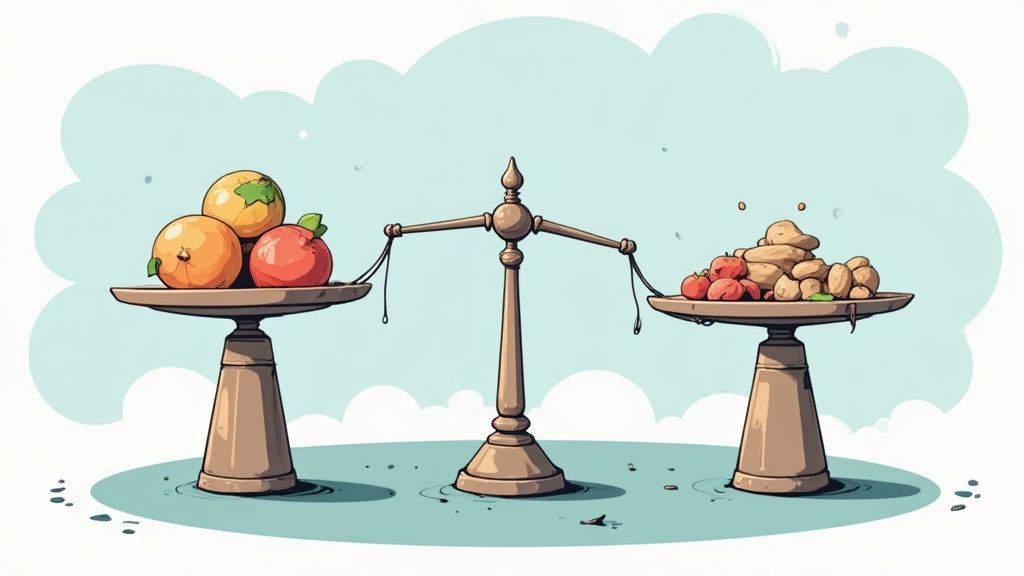10 Proven Strategies to Boost Project Management Efficiency in Your Organization
The Reality of Project Management Efficiency Today

Companies invest heavily in project management tools hoping to achieve smooth execution and predictable results. Despite these investments, many teams still struggle to meet their goals. This mismatch between goals and outcomes raises important questions about how teams can actually improve their project management practices.
The Efficiency Gap: Perception vs. Reality
Teams often think they're working efficiently because they use popular project management software and follow standard methodologies. But real efficiency comes down to delivering results, not just using tools. A common scenario: A team meticulously updates their project tracking software but repeatedly misses key deadlines. Several factors contribute to this disconnect, including poor time estimates, communication breakdowns, and mismatched resource planning.
Common Barriers to Project Success
Meeting deadlines and budgets remains a persistent challenge. Research shows that only 34% of projects are completed on time, and the same percentage stay within budget. These statistics come from detailed project management research by Monday.com. Other frequent roadblocks include unclear communication between team members, scope creep, and confusion about who owns which tasks. When these issues overlap, they create a snowball effect that derails project timelines.
Best Practices of High-Performing Teams
The most successful project teams share several key habits that drive their results:
Clear Communication: They make sure everyone knows project status and next steps
Defined Scope: They set clear boundaries and goals before starting work
Flexible Planning: They adjust their approach when circumstances change
These teams understand that success requires more than just following a rigid plan. They regularly step back to review what's working and what isn't. This focus on continuous improvement helps them tackle new challenges effectively and consistently deliver better results. Other teams can learn from these practices to strengthen their own project management approach.
Mastering Data-Driven Project Decisions

Smart project management uses data, not just gut feelings. Good project data helps teams spot issues early and make better choices. Let's look at how successful teams use real-time information to guide their projects.
Building Meaningful Metrics
Not all project metrics matter equally. Simply counting finished tasks tells only part of the story. Focus on key performance indicators (KPIs) that directly show if you're meeting project goals. Good KPIs should be easy to measure and lead to clear actions. When a KPI changes, you should know exactly what to do next.
Real-Time Data: The Key to Agile Project Management
Quick access to current project data helps teams work smoothly. Yet many organizations struggle with this - 55% lack real-time KPI tracking. This forces managers to work with outdated information. Even worse, 50% spend a day or more creating reports manually, as noted in Workamajig's project management research. This shows why teams need good systems that provide fresh project data on demand.
Analytics Combined With Experience
Data works best when paired with skilled project management. Think of project data like a detailed map - it shows the full picture, but you still need experience to choose the best path forward. Good project managers can spot patterns in the data, predict potential problems, and adjust plans to keep things on track.
Implementing Data-Driven Practices
Moving to data-driven project management needs more than just new tools - it requires new habits. Here's how to start:
Set clear project goals: Know what success looks like
Pick KPIs that match those goals: Focus on what truly counts
Get tools that show live data: Choose systems that help quick decisions
Share data with everyone: Keep the whole team informed
Check data regularly: Use insights to improve
These steps help teams use data to work more efficiently and get better results. Some people might resist this change at first, but showing how data reduces risks and improves planning usually wins them over. This approach lets teams solve problems before they grow, rather than just reacting to issues.
Making Project Resources and Costs Work Better

The success of any project depends heavily on smartly using resources and keeping costs in check. Let's explore practical ways organizations make this work, even with tight budgets and demanding projects.
Smart Resource Planning
Planning your project resources is like planning a meal - you need the right amounts at the right time. Resource planning means figuring out exactly what you'll need - whether that's people, equipment, or money - and making sure it's ready when you need it. Looking at past projects helps a lot here. For instance, if your last website redesign needed three developers for eight weeks, that's useful information for planning your next similar project.
Keeping Budgets on Track
Going over budget can kill a project, but there are practical ways to prevent this. Start by setting realistic budgets that include some extra room for unexpected costs. Keep a close eye on spending compared to your plan - this helps catch problems early. Regular budget reviews make it easier to spot and fix issues before they grow. The cost of poor project management is stark - companies waste about 11.4% of their project investments due to poor performance, which means nearly $99 million lost for every $1 billion spent. For more insights, check out Project Management Statistics.
Smart Team Management
While getting the most from your resources matters, pushing too hard hurts more than it helps. Good team management means giving people work that matches their skills and availability. When you assign the right tasks to the right people, everyone works better. Include time for breaks and learning - these aren't extras, they're essential for keeping your team productive.
Flexible Resource Management
Projects rarely go exactly as planned, so you need ways to adjust quickly. Having clear priorities helps you move resources around when needed without causing chaos. For example, if an important task falls behind, you might need to move people from less urgent work to help catch up. Regular team check-ins are vital - they help you spot potential problems early and keep work flowing smoothly. Having open discussions about workload helps prevent bottlenecks before they cause real trouble.
Creating High-Performance Project Teams That Last

Building exceptional project teams goes beyond just gathering talented people. The real magic happens when you create an environment where people can thrive through open communication, clear goals, and mutual trust. Great teams develop through careful planning and consistent effort to improve project outcomes.
Essential Elements of Top Teams
The most successful project teams share these core traits:
Mix of Skills: Bringing together different talents and perspectives leads to better solutions and more creative problem-solving
Clear Direction: Teams excel when everyone understands both the big picture goals and their specific role
Strong Leadership: Good leaders keep communication flowing, handle conflicts early, and help teams stay focused
When these pieces come together, teams can tackle complex challenges and deliver outstanding results.
Making Communication Work
Clear communication keeps projects running smoothly. When messages get mixed up, work gets duplicated and deadlines slip. While project management tools help track tasks, the real improvement comes from creating an environment where team members feel comfortable sharing ideas and concerns openly.
Quick Daily Updates: Brief team check-ins help everyone stay aligned without wasting time
Project Tracking Tools: Using visual tools to monitor progress helps spot potential issues early
Building Trust and Getting Results
Teams do their best work when members feel safe trying new approaches. At the same time, each person needs to own their responsibilities and meet clear expectations. Here's what helps teams succeed:
Regular Input: Give and receive feedback often to keep improving
Celebrate Wins: Acknowledge good work to keep motivation high
Working Through Tough Spots
Every project hits rough patches - whether it's tight deadlines or resource constraints. Strong teams turn these challenges into chances to learn and grow. Here's how to handle bumps in the road:
Clear Problem-Solving Steps: Have a plan ready for common issues
Progress Reviews: Check project status regularly to catch problems early
By focusing on these fundamental areas, teams can deliver great results now while building skills for future success. The key is staying flexible and committed to learning from each experience.
Engineering Efficient Project Workflows
https://www.youtube.com/embed/gJCS1gqk8ME
Building on our previous discussion of resource management, let's explore how to optimize your project workflows. Think of project workflows like a well-oiled machine - each component needs to work smoothly with the others. We'll look at practical ways to spot bottlenecks, automate repetitive work, and improve processes while maintaining quality.
Identifying and Eliminating Efficiency Killers
Start by finding what slows your projects down. Common issues include excessive meetings, complex approval chains, and unclear team roles. Picture a design team waiting days for simple approvals while other work sits idle. To spot these problems, map out your current workflow step-by-step. This simple visualization often reveals hidden slowdowns that weren't obvious before.
Automating While Keeping it Personal
Many teams want to automate tasks but worry about losing the human element. The key is finding the right balance. Simple automations like deadline reminders can free up your team to focus on creative problem-solving and meaningful collaboration. Look for repetitive tasks that machines can handle so people can concentrate on work that requires human judgment.
Making Workflows Simpler and Smoother
Think about ways to remove unnecessary steps from your processes. Could you combine multiple approval stages? Create templates for common tasks? Like organizing a messy desk, removing extra steps creates room to work better. When processes flow naturally, teams can focus on delivering results rather than fighting through red tape.
Finding the Sweet Spot Between Structure and Adaptability
While consistent processes help teams work faster, you also need room to adapt when things change. Projects rarely go exactly as planned, so build some flexibility into your system. Tools like Obsibrain can help by providing structure while allowing quick adjustments as needed.
Helping Teams Embrace New Ways of Working
When updating workflows, clear communication is essential. Explain what's changing and why it matters. Provide training and support to help everyone get comfortable with new processes. Taking time to bring the team along helps prevent disruption and keeps morale high during transitions.
Keeping Projects Moving Through Tough Spots
Even well-designed workflows can hit snags during complex projects. Regular progress checks help spot potential issues early. Stay proactive about removing obstacles so teams can maintain their momentum. By combining smart processes with consistent monitoring, you can help projects stay on track and deliver strong results on time and within budget.
Building Tomorrow's Project Management Foundation
Project management keeps changing and improving. To get better results, we need to understand what's coming next. Let's explore how artificial intelligence (AI), predictive analytics, and modern automation tools are improving how we run projects today.
The Rise of AI in Project Management
Artificial Intelligence is becoming a practical tool that project managers use daily. Modern AI software can spot potential delays by analyzing past project data and suggest better ways to assign team members to tasks. By examining how teams communicate, AI helps identify and fix collaboration issues early. This helps projects stay on track and deliver better results.
Predictive Analytics: Anticipating Project Roadblocks
Project managers now use data analysis to spot problems before they happen. This isn't guesswork - it's about making smart decisions based on real information. For example, if the data shows a task might go over budget, managers can investigate why and fix the issue early. This makes budgeting more accurate and helps avoid expensive surprises later.
Advanced Automation: Streamlining Project Workflows
Today's automation goes beyond simple task scheduling. Modern tools can handle complex jobs like matching the right people to specific tasks or checking for potential risks. This frees up teams to focus on solving problems and planning ahead. Good automation helps get work done faster by putting the right people on the right tasks at the right time.
Adapting to the Future of Project Management
Getting the most from new project tools requires an open mind. Project managers should get comfortable using data to make decisions and always look for ways to improve. This means testing new methods, building flexible systems, and staying up to date with useful project management developments.
Practical Steps for Building Your Future-Ready Foundation
Here's how to help your team prepare for modern project management:
Train your team: Make sure everyone knows how to use new tools effectively
Start small: Try one new tool or method at a time before adding more
Keep data clean: Good data leads to better AI and analytics results
Try new things: Let your team test different approaches and learn what works best
Keep learning: Stay informed about helpful new project management tools
Good project management means always finding better ways to work. Using modern tools and adapting to change helps teams do their best work. Want to try these ideas in practice? Check out Obsibrain, a productivity platform that helps teams work better together. Start your free trial today to see how it can help your projects succeed.
Last updated
Was this helpful?